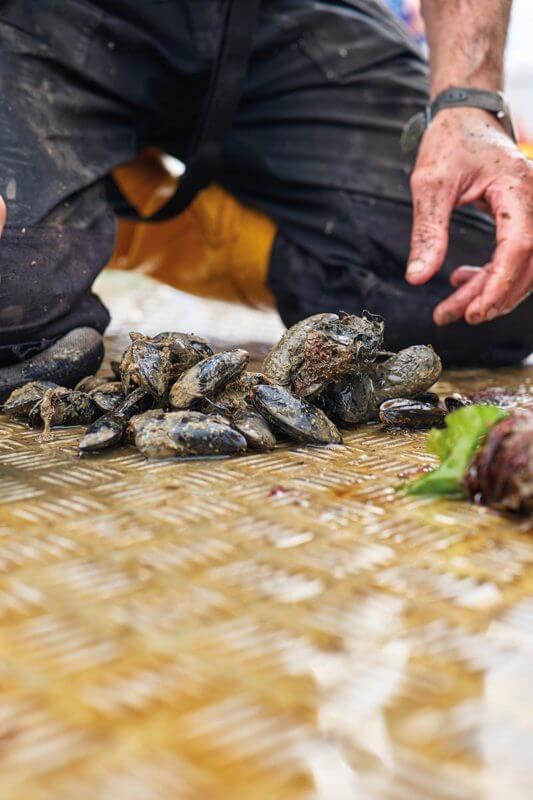
A growing industry is taking sustainable seaweed farming to new depths
By Bryony Cottam
Polyculture is the practice of growing more than one crop in the same space – an attempt to mimic the diversity of a natural ecosystem. In a marine environment, this practice takes on a three-dimensional form, using the entire water column to farm species from different trophic levels. The uncatchy term used for this approach is ‘integrated multi-trophic aquaculture’. But ‘we call it regenerative ocean farming,’ says marine farmer Jon Haines.
Haines is a member of Câr-Y-Môr, a community-owned and operated aquaculture project that has just been granted a licence to establish the first commercial seaweed and shellfish farm in Wales. Câr-Y-Môr, which means ‘for the love of the sea’, was created by fisherman Owen Haines out of concern that wild harvesting of seaweed, which has a long history in Wales, was becoming unsustainable.
So far, roughly 15 tonnes of seaweed have been harvested from two trial farms in Ramsey Sound, Pembrokeshire, which consist of vertical seaweed lines and shellfish socks suspended at different depths. It’s zero-input farming, requiring no fresh water, fertilisers or land, and cultivating only native species: kelp, oysters, mussels and clams.
When we speak, Jon Haines is attending a WWF conference in Maine, where veteran lobster farmers have been getting their off-season income from kelp farming for some time now. It’s Seaweed Week and the local crop is on menus everywhere in Portland, in everything from burgers to beer. ‘It’s definitely five to ten years ahead of where we could be in the UK,’ he says.

Back at the Welsh farms it won’t be much longer before it’s seaweed-seeding season. ‘Our two-metre seaweed lines are wrapped with twine that has baby, almost microscopic seaweed seeded on it,’ says Haines. ‘This seaweed grows out and attaches itself to the main line, ready for us to harvest it in the spring.’ Getting the seed from the seaweed’s spore-bearing tissue (sorus) is the most difficult part of the process and Câr-Y-Môr has teamed up with Plant Ecology Beyond Land, which has a seaweed hatchery on Anglesey where species are cultivated in carefully controlled tanks.
The seeds sprout the crinkly fronds of sugar kelp, which share the lines with oarweed that has naturally settled there. Local species that can be wild-harvested include dulse and pepper dulse – known for their almost bacon-like flavour – sea spaghetti, winged kelp, sea lettuce and laver. ‘The aim is to try to get as many on the farm as possible,’ says Haines. ‘We visited the farm over the last year and all of these species that we’re wild harvesting have settled there, so it’s a really good indication that if we can crack the life cycle in the hatchery, then cultivating all of these species could become a reality.’
There are a few bold claims about seaweed farming’s benefits, but just how much carbon it has the potential to store is a complex question that requires more research. There are, however, studies that show that seaweed farming buffers marine organisms within the farm from ocean acidification caused by the build-up of atmospheric CO2. They also enhance biodiversity, serving as shelter, feeding and nursery areas for an array of fauna. At Câr-Y-Môr, the evidence so far is anecdotal, but Haines says: ‘Every time I’ve ever visited, it’s amazing what you see specifically within the seaweed line – baby eels and all sorts of different things living in and on the seaweed, which is really exciting.’


